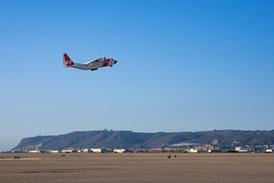Mark Hannant
Ibis Aerospace has unveiled the first full-scale mock up of its Ae270 here at the Show (Hall 1 Stand D/38). Outstanding regulatory issues with the Czech government mean that Ibis, a 50/50 joint venture between Aero Vodochody and Taiwan¹s Aerospace Industrial Development Corporation, has still not been able to fly its prototype. But it comes to the show confident that it will achieve FAR Part 23 certification a year from now.
Modern
The mock up of the single engine turboprop features an eight-passenger commuter seating configuration. Visitors enter through the large passenger/cargo door at the rear of the cabin. The state-of-the-art flight deck features modern flat panel displays in which the instruments are powered and operational.
The Ae270 is powered by a Pratt & Whitney Canada PT6A-42 engine. It will carry up to 10 people (including two crew) over stage lengths of up to 1,250nm. Alternative configurations include a 6-7 passenger executive formation, and Ibis believes the $1.895 million price tag makes it attractive to multiple-purchase charter operators and brings it within the reach of owner-flyers.
Speaking at the start of the show Ibis general manager, Milos Valis says: ³The Ae270 is redefining the mission capability and economics of general aviation aircraft for the new millennium. We eagerly anticipate the first flight of the Ae270. As soon as we have received all the proper paperwork, our flight test department will be ready for take-off. First flight will be accompanied by a Let L-200 Morava and an L-39 jet trainer will be aloft for aerial observation.²
He accepts the delays experienced thus far are because this is the first civil project, other than sports aircraft, for designers and regulatory authority inspectors in the Czech Republic. Three test flights will take place prior to handing over the aircraft to the Aeronautical Research and Test Institute near Prague where frequency analysis testing will be performed.
Manufacturing and final assembly will be handled by Aero Vodochody, which claims to have historically achieved production volume of as many 200 aircraft per year - and implies that it will aim for that level of Ae270 production.
Design
The Ae270 has been designed by chief designer Jan Mikula, who has been designing aircraft since the 1950s and was responsible for the design of all five of the Lockheed Trophy-winning Czech aerobatics aircraft during the national team¹s heyday in the late 1950s and early19 60s.Valis adds the Ae270 is primarily influenced by a desire to create, ³something as great as the DHC-3 Otter, An-2 Colt and Let L410. ³Ten years ago it was obvious that piston popularity was fading. Since turbine engines are more reliable than pistons and statistically fewer accidents have occurred with single engine aircraft. The emergence of the Ae270 has been met with great enthusiasm.²
Source: Flight Daily News























